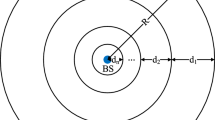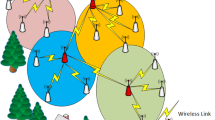Abstract
A simulation model of balanced energy consumption for wireless sensor networks (WSNs) is proposed to solve the uneven energy consumption problem in WSN that leads to the rapid death of some nodes and the occurrence of blind spots. The model consists of five parts: a hierarchical model, an energy consumption model, a cluster filtration model, a data transmission model, and a cluster model. It forms a complete scheme that can effectively solve the problems of unreasonable cluster head selection, uneven clustering, and poor network robustness in WSN networking by combining energy consumption depolarization strategies to fill the gap of set optimization scheme. A clustering method is proposed to equalize node load, and an adaptive two-cluster model is used in accordance with node location to equalize network energy consumption. The simulation results show that the proposed energy consumption model can significantly improve the overall performance of the network. The network lifetime is extended by about 120%, the total data transmission per unit of energy is improved by 51% on average, the redundant data generation is reduced by 44.2%, and the localization tracking success rate is reduced by only 2.14%.















Similar content being viewed by others
References
Abbasian Dehkordi S, Farajzadeh K, Rezazadeh J et al (2020) A survey on data aggregation techniques in IoT sensor networks. Wireless Netw 26:1243–1263. https://doi.org/10.1007/s11276-019-02142-z
Famila S, Jawahar A, Sariga A, Shankar K (2020) Improved artificial bee colony optimization based clustering algorithm for SMART sensor environments. Peer-to-Peer Networking and Applications 13(4):1071–1079. https://doi.org/10.1007/s12083-019-00805-4
Marques B, Ricardo M (2017) Energy-efficient node selection in application-driven WSN. Wireless Netw 23:889–918. https://doi.org/10.1007/s11276-016-1194-2
Heinzelman W R, Chandrakasan A, Balakrishnan H (2000) Energy-efficient communication protocol for wireless microsensor networks[C]// hicss. IEEE Computer Society, https://doi.org/10.1109/HICSS.2000.926982
Handy MJ, Haase M, Timmermann D (2002) Low energy adaptive clustering hierarchy with deterministic cluster-head selection[C]// Mobile and wireless communications network, 2002. 4th international workshop on. IEEE, 10.1109/M WCN.2002.1045790
Sivakumar P, Radhika M (2018) Performance analysis of LEACH-GA over LEACH and LEACH-C in WSN[J]. Procedia Computer Science 125:248–256. https://doi.org/10.1016/j.procs.2017.12.034
Shi S, Liu X, Gu X (2012) An energy-efficiency optimized LEACH-C for wireless sensor networks. 7th international conference on communications and networking in China, Kunming, China, 487–492, https://doi.org/10.1109/ChinaCom.2012.6417532.
Arjunan S, Pothula S (2019) A survey on unequal clustering protocols in wireless sensor networks. Journal of King Saud University-Computer and Information Sciences 31(3):304–317. https://doi.org/10.1016/j.jksuci.2017.03.006
Lu X, Chen R, Liu J, et al. (2018) Square partition-based node scheduling algorithm for wireless passive sensor networks[J]. International Journal of Communication Systems e3531. https://doi.org/10.1002/dac.3531.
Baoyu WU, Peng W, Gaofeng W, et al. (2019) Energy grading charging strategy for wireless rechargeable sensor network[J]. Chinese Journal of Sensors and Actuators, http://en.cnki.com.cn/Article_en/ CJFDTotal-CGJS201908021.htm.
Zhang J, Yan R (2019) Centralized energy-efficient clustering routing protocol for mobile nodes in wireless sensor networks. IEEE Communications Letters PP.99:1–1. https://doi.org/10.1109/LCOMM.2019.2917193.
Singh Sunil Kumar, Kumar Prabhat, Singh Jyoti Prakash (2017) A survey on successors of LEACH protocol. Ieee Access 5:4298–4328. https://doi.org/10.1109/ACCESS.2017.2666082
Song J, Ma ZY, Xu S, Definition and derivation of algorithmic energy consumption complexity [J]. J Comput Sci, 2018, 041(003):709–723. https://doi.org/10.11897/SP.J.1016.2018.00709
Zhang Y, Liu TT, Zhang HG et al. (2020) LEACH-R: LEACH relay with cache strategy for mobile robot swarms[J]. IEEE Wirel Commun Lett https://doi.org/10.1109/LWC.2020.3033039
Aierken N, Gagliardi R, Mostarda L, et al. (2015) RUHEED-rotated unequal clustering algorithm for wireless sensor networks[C]//2015 IEEE 29th international conference on advanced information networking and applications workshops. IEEE, 170–174. https://doi.org/10.1109/WAINA.2015.86
Jin Z, Kim DY, Cho J et al (2015) An analysis on optimal cluster ratio in cluster-based wireless sensor networks[J]. IEEE Sens J 15(11):1–1. https://doi.org/10.1109/JSEN.2015.2459374
Pei E, Pei J, Liu S et al (2019) A heterogeneous nodes-based low energy adaptive clustering hierarchy in cognitive radio sensor network[J]. IEEE Access 7:132010–132026. https://doi.org/10.1109/ACCESS.2019.2940726
Sarkar A, Senthil Murugan T (2017) Cluster head selection for energy efficient and delay-less routing in wireless sensor network[J]. Wireless Networks, https://link.springer.com/content/pdf/https://doi.org/10.1007/s11276-017-1558-2.pdf.
Ghosh N, Banerjee I, Sherratt RS (2019) On-demand fuzzy clustering and ant-colony optimisation based mobile data collection in wireless sensor network[J]. Wireless Netw 25(4):1829–1845. https://doi.org/10.1007/s11276-017-1635-6
Khan FA, Farooqi AH, Derhab A (2019) A comprehensive security analysis of LEACH++ clustering protocol for wireless sensor networks[J]. Journal of supercomputing 75(4):2221–2242. https://doi.org/10.1007/s11227-018-2680-3
Nayebia, Sarbaz-Azad H (2011) Performance modeling of the LEACH protocol for mobile wireless sensor networks[J]. J Parallel Distrib Comput 71(6):812-821. https://doi.org/10.1016/j.jpdc.2011.02.004
Wu X, Zeng X, Fang B (2018) An efficient energy-aware and game-theory-based clustering protocol for wireless sensor networks[J]. ICE Transactions on Communications E101.B(3):709–722. https://doi.org/10.1587/transcom.2017EBP3195
Hemavathi N, Meenalochani M, Sudha S (2020) Influence of received signal strength on prediction of cluster head and number of rounds[J]. IEEE Trans Instrum Meas 69(6):3739–3749. https://doi.org/10.1109/TIM.2019.2932652
Abidi W, Ezzedine T (2019) Effective clustering protocol based on network division for heterogeneous wireless sensor networks[J]. Computing 102(1). https://doi.org/10.1007/s00607-019-00757-w.
Jarwan A, Sabbah A, Ibnkahla M (2019) Data transmission reduction schemes in WSN for efficient IoT systems[J]. IEEE J Sel Areas Commun 37(6):1307–1324. https://doi.org/10.1109/JSAC.2019.2904357
Deng J, Han YS, Heinzelman WB et al (2005) Scheduling sleeping nodes in high density cluster-based sensor networks[J]. Mob Networks Appl 10(6):825–835. https://doi.org/10.1007/s11036-005-4441-9
Weiqi C, Han C, Quansheng G, et al. (2018) Evolutionary sleep scheduling in software-defined networks[J]. IEEE Access, PP:1–1. https://doi.org/10.1109/ACCESS.2018.2841985
Wan R, Xiong N, Loc NT (2018) An energy-efficient sleep scheduling mechanism with similarity measure for wireless sensor networks[J]. Human-Centric Computing and Information Sciences 8(1). https://doi.org/10.1186/s13673-018-0141-x.
Li W, Ren XL (2019) Dormancy scheduling strategy for wireless sensor network nodes based on data similarity[J]. Journal of Sensor Technology 32(12):1881–1888. https://doi.org/10.3969/j.issn.1004-1699.2019.12.019
Gupta N, Kumar N, Jain S (2016) Coverage problem in wireless sensor networks: a survey[C]//2016 international conference on signal processing, communication, power and embedded system (SCOPES). IEEE: 1742–1749. https://doi.org/10.1109/SCOPES.2016.7955741.
Zhang S, Li J, Yang Q, et al. (2019) Residual-energy aware LEACH approach for wireless sensor networks[C]//2019 eleventh international conference on ubiquitous and future networks (ICUFN). IEEE 413–418. https://doi.org/10.1109/ICUFN.2019.8806186.
Heinzelman WB, Chandrakasan AP, Balakrishnan H (2002) An application-specific protocol architecture for wireless microsensor networks[J]. IEEE Trans Wireless Commun 1(4):660–670. https://doi.org/10.1109/TWC.2002.804190
Funding
This work was supported in part by the National Natural Science Foundation of China (62176067); National Key Research and Development Program of China (SQ2020YFF0416833); Scientific and Technological Planning Project of Guangzhou (201903010041, 202103000040); Key Project of Guangdong Province Basic Research Foundation (2020B1515120095); and Project Supported by Guangdong Province Universities and Colleges Pearl River Scholar Funded Scheme (2019).
Author information
Authors and Affiliations
Corresponding author
Ethics declarations
Conflict of interest
The authors declare no competing interests.
Additional information
Publisher's note
Springer Nature remains neutral with regard to jurisdictional claims in published maps and institutional affiliations.
Rights and permissions
About this article
Cite this article
Lu, X., Chen, K. & Chen, R. Balance: depolarized intelligent sensing system with multi-angle energy-saving optimized control model. Ann. Telecommun. 77, 835–846 (2022). https://doi.org/10.1007/s12243-022-00913-y
Received:
Accepted:
Published:
Issue Date:
DOI: https://doi.org/10.1007/s12243-022-00913-y




